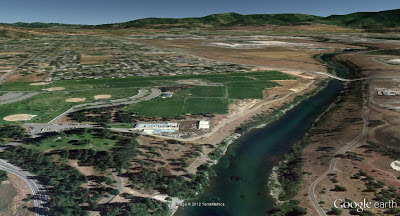The National Trust for Historic Preservation is in the house! This is one of the largest conferences that Spokane has hosted, certainly the largest history-themed conference, and it seems to be going really well. Today I gave a presentation, learned about plotting historic trails, explored three sites of a proposed new national park, heard some dubious historical interpretation, and met a lot of interesting people.
I only attended half the day today, and my first activity was presenting at my own session, Using Mobile Interpretation to Strengthen Preservation Communities. Here are the slides--though I am not sure how much sense they make without my presentation:
In the afternoon I attended two sessions.
Happy Trails! Going to Great Lengths to Preserve National Historic Trails was fascinating but should have been subtitled Going to Great Lengths to FIND National Historic Trails. The three panelists described their work on three historic trails--Dave Crowley of the BLM on the Oregon Trail, Angie Krall of the Forest Service on the
Old Spanish Trail, and Julie McGilvray of the NPS on the
Butterfield Stage Route. What fascinated me was the incredibly painstaking work each person did with old maps, surveyors notes, and painstaking archaeology to pinpoint the routes and campsites of these long-vanished routes. Their identifications hinged on such items as a copper shell casing, a broken Spanish bridle bit, and a shard from a whiskey bottle. Locating these routes is fine-grained detective work.
My second afternoon session was
Interpreting the History of the Atomic Age. This session featured presenters for the three sites of the proposed
Manhattan Project National Monument. Ethiel Garlington explained some of the preservation issues at Oak Ridge in Tennessee, Colleen French ("I'm just a girl who fell in love with a reactor") explained the special problems at Hanford where historic preservation takes a necessary back seat to cleaning up hazardous materials, and Heather McClenahan told us about Los Alamos.
I have to think that this session was planned, earlier in the year when proposals were submitted, as an announcement of a new national park. As late as this summer it seemed like the proposed park was on the fast track. But in September the bill failed, at least for now, partly on the objections of Congressman Dennis Kucinich. "At a time when we should be organizing the world toward abolishing nuclear weapons before they abolish us, we are instead indulging in hideous admiration at our cleverness as a species. The Bomb is about graveyards, not National Parks,"
said Kucinich. The Park Service will likely try again, but for now there is no Manhattan Project Park
One of the reasons for the failure was unintentionally made clear during the session, where two of the five presenters engaged in weird digressions from their subjects to deliver endorsements of the decision to drop the atomic bombs on Japanese cities. Session chair Sean Smith of the National Parks Conservation Association stated that there was absolutely no evidence that the Japanese were considering surrender and gave very high estimates of casualties if the Americans had invaded. McClenahan added at the end of her presentation (which until that moment had been about preserving historic buildings in New Mexico) that some people disputed the high casualty figures if an invasion had been necessary but how do those people explain then why the U.S. manufactured so many Purple Hearts for the invasion of Japan that the military did not use up the the supply until recently?
These asides were both completely irrelevant to the presentation and bad history. Smiths claims were naive. Japan sent out what
many historians believe was a peace feeler to the United States before the dropping of the first bomb. There is plenty of evidence that some of the high casualty figures for an invasion of the Japanese mainland were manufactured
after that war as post-facto justifications for the use of atomic bombs on civilian populations. And as for the purple hearts surplus--the United States also exited the war with a surplus of toilet paper, so much that some government agencies used WW2 army toilet paper into the 1960s. Gentle reader, I will allow you a moment to make your own joke here. You do not have to be opposed to the decision to drop the bomb (I personally feel it was the right call) to object to these presentations.
Besides being poor history, the pro-bomb arguments were wildly out of place and do real damage to the laudable cause of creating this national park. It was very like hearing a presentation on why we need a new Civil War park interrupted by an explanation of how the South was right about states rights, or "Manifest Destiny: Not So Bad" as the tagline for a new westward expansion monument.
In the question session an audience member mentioned that the mayor of Nagasaki had sent a letter to President Obama, opposing the creation of the park. I wonder why?
I should not make too much of this--both presenters spent only a few minutes defending the bomb in otherwise excellent presentations. I look forward to tomorrow!


























